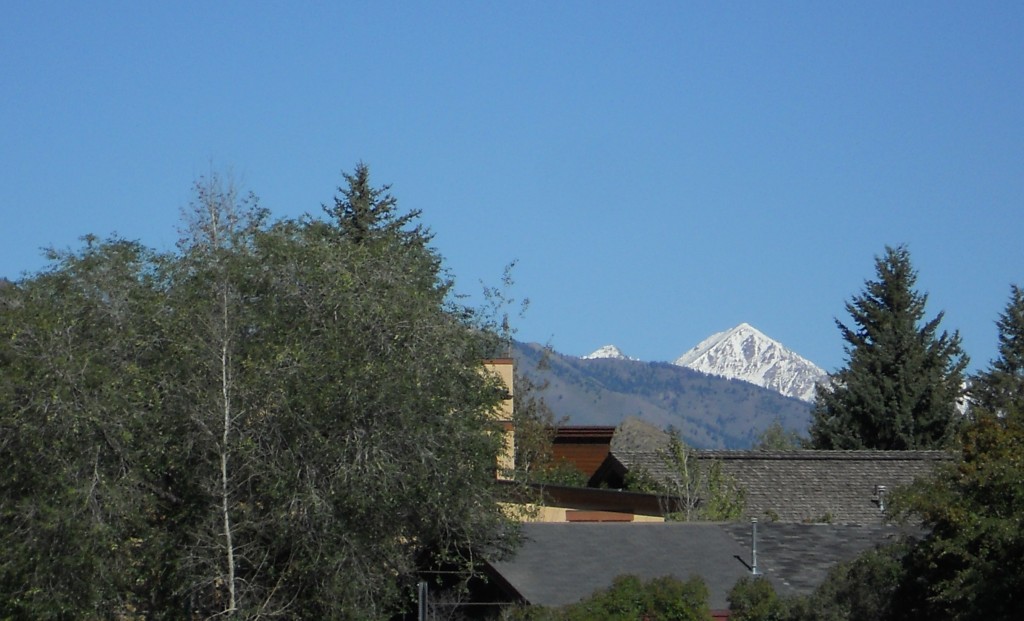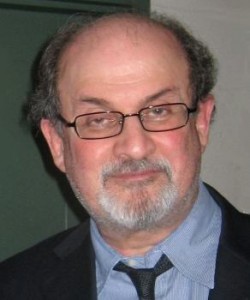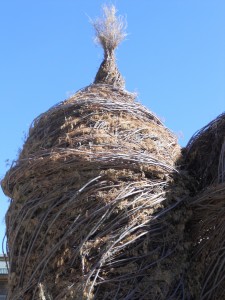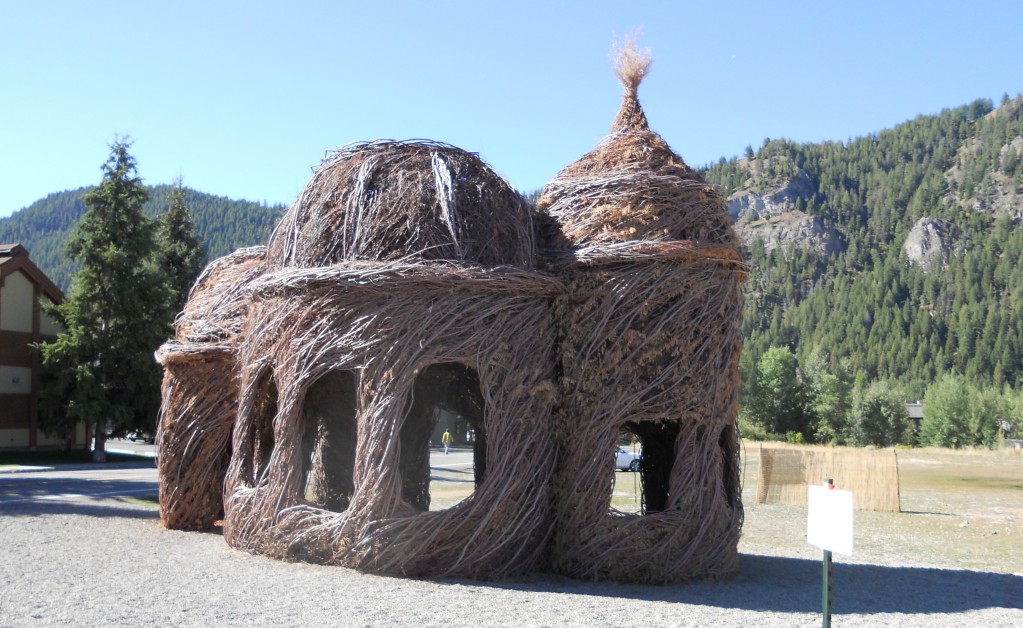
By Bob Hicks
Mr. Scatter has been traveling the byways of America quite a lot of late, and by a quirk of fate he found himself in an open pavilion in Sun Valley, Idaho, on the eve of September 11, listening to Salman Rushdie talk about Charles Dickens, Jane Austen, Sarah Palin, the nonpolitical and political natures of art, the difficulties of free speech and the true perils of reactionary jihadism.
The unlikeliness, and yet the unabashed Americanness, of this event occurring in this place and at this time, nine years minus a few hours after the jihadist suicide attacks on the World Trade Center and the Pentagon, was perhaps less ironic than celebratory. It was proof, in a way, that in a world wracked by violent religious and cultural insanity, good sense and mere goodness can survive.
Rushdie suddenly and rudely became an international expert on free speech and jihadist militance, as you may recall, one day in 1989 when Iran’s Ayatolla Ruhollah Khomeini issued a fatwa against him, calling on all true and loyal Muslims to wipe the Indian-born British novelist off the face of the earth for purported insults to Mohammed to be found in Rushdie’s novel The Satanic Verses, copies of which few swept up in the fatwa fever had actually read.
 Hitoshi Igarashi, the Japanese translator of The Satanic Verses, was indeed assassinated, and two other translators eluded attempts at murder (let’s strip away the whitewash and call this what it was). Rushdie continued to write, and publish, and increasingly to speak in public, where he’s developed a reputation as a practiced entertainer. Twenty-one years ago, he told his Idaho audience, Khomeini announced that the two of them couldn’t live together on the same planet. Today, the ayatollah’s prophecy has been fulfilled: One of them is dead, and it’s not Rushdie.
Hitoshi Igarashi, the Japanese translator of The Satanic Verses, was indeed assassinated, and two other translators eluded attempts at murder (let’s strip away the whitewash and call this what it was). Rushdie continued to write, and publish, and increasingly to speak in public, where he’s developed a reputation as a practiced entertainer. Twenty-one years ago, he told his Idaho audience, Khomeini announced that the two of them couldn’t live together on the same planet. Today, the ayatollah’s prophecy has been fulfilled: One of them is dead, and it’s not Rushdie.
*
Sun Valley and its cluster of neighbors near the Big Wood River and the East Fork Wood River in central Idaho — Bellevue, Hailey, Ketchum — are at the southern base of the vividly named Sawtooth Mountains, the beginning of high alpine country. Getting there from Boise is close to a three-hour drive in good weather, and like other vast stretches of the interior West, it reminds you forcibly of the precious and perilous place that water holds in the continuing life of the continent.
On lonely ribbon roads you traverse a land of grain elevators, power lines, barbed-wire fences, hay bales stretched a freight car long and four men high. You’re a mile above sea level, and this is prairie, or desert, or you name it. It’s hot and windy, gold and sage, with hills on either side that look like sheep just shorn, stubble over bodies of stone. Easing through the long loops and short switchbacks of the two-lane road north of Mountain Home, you see far more cows than people or cars. Anything different, you notice. The road signs say things like this: “Open Range.” “Game Crossing Next 9 Miles.” “Watch for Stock.” “No Services 56 Miles.” It’s high hard country, and you can understand why a person would love it, or hate it, or love it and hate it at once. It can hold a person, willing or no. You battle it and yield to it, and its great expanse can make you feel as big as God and infinitesimally small.
By the time you reach the Big Wood Valley and the gold begins to turn to green, it feels as if you’ve reached the promised land. The valley draws people, and sometimes repels them. Ezra Pound was born in Hailey but didn’t stay long. Ernest Hemingway spent a good share of his last 20 years in Sun Valley and Ketchum, hunting and catching stream trout and eventually pulling the trigger on a rifle stuck in his mouth. He and his granddaughter Margaux, who was born in Portland, are buried in the Ketchum cemetery.
*
So. Here in this isolated little skiing capital in the south center of a state not always known for its liberal tendencies (the Aryan Nation thrives, sort of, north of here) stood this casually professorial bearded man, part artist, part intellectual historian, part standup comic, one of our most potent symbols for the meaning and price of freedom, taking offhand pot shots at easy right wing targets as he primed the crowd for deeper investigations of who we are, how we got here, where we might be headed. Unlikely world events have transpired to turn Rushdie into a public figure, not unlike Dickens, whom he applauded in his speech both for the showmanship of his lecture tours and the political impact of his art. In a way Rushdie has no choice; or rather, his alternative is to simply shrink away into the sort of silence he did not accept even when he was in hiding for his life.
All things considered, he seems to have taken on the mantle of celebrity with a fair amount of grace, and even eagerness. In his speeches, he wants to sound clever and be liked, and he sometimes casts a little shallowly in his quest for easy laughs. It’s almost too easy to forget that at some basic level, Rushdie’s road show is an act of courage. The shadow of the Rushdie fatwa still falls over the likes of the 2004 assassination of Dutch filmmaker Theo van Gogh and the current case of Seattle cartoonist Molly Norris, who has “gone ghost” at the FBI’s insistence after her satirical call for an “Everybody Draw Mohammed Day” led to assassination threats against her. Every public, and even private, step that Rushdie takes is a risk. The fatwa may be in limbo (the steam’s gone out of it, although Islamic hardliners insist it’s still in effect), but it’s never as easy as that. One zealot can change the equation forever. Until the end of his days, be they long or short, Rushdie is a target. That makes him a rare thing for a novelist: He is even more important for who he is than what he writes.
*
Driving through the alternately harsh and lush beauties of Idaho, it struck me again how closely intertwined belief and home and landscape are. Place matters. Connection to the close-at-hand can inspire fierce devotion and an abiding belief in the exceptionality of this one place, whether the place is geographical or a regionalism of the imagination. Often the exceptionalism is mainly in our minds. Sometimes the places we love actually are exceptional. You could say an Idaho potato is an Oregon potato is a Maine potato and unless you live in Idaho, Oregon or Maine, who cares? But the reputation of a good Idaho trout is only speaking the truth. In Ketchum I had one so fresh and light I should have prayed to it. Is it any wonder that God is not dead in the America off the freeway grid, and that He, or She, or It, is so identified with the embracing of place? Rushdie’s sin, in The Satanic Verses, was to cast doubt on the validity of a fierce devotion to a particular place of the soul. The religions of the Middle East, created from the particular situations of nomadic desert tribes, are infused with images of the holiness of place: burning bushes, rocks of safety, oases, sacrificial stones, magic mountains, shifting sands. There is ground, surely. But can there be common ground?
*
Waiting in the Boise airport near the end of my trip I read the last few pages of A Touch of Oregon, Ralph Friedman‘s 1970 collection of essays and profiles on old-time Oregonians, which I’d picked up a few weeks earlier in a used-book store on the Oregon coast. In his introduction, Friedman, who was best known for his minor classic Oregon for the Curious, freely confesses his love for the place and its people. But his love, he insisted, was not blind:
Let this book … not be construed as a huckster’s pitch for Oregon. I am not uncritical of much that I have seen here. Years before it became popular, I was pointing to the many faces of pollution. I have seen beauty despoiled in every part of the state and in this book I have again sounded my feelings on this grim subject. My writings on Oregon have never suggested that this is the most ‘beautiful’ or ‘fascinating’ of the 50 states. It happens that at this time of my life I know Oregon better than I do any other state. Had I lived, say, in Montana or North Dakota I would probably have written about any of them with as much affection — and agony.
This sense of critical love — the understanding that even the particular paradises of our individual choosings have their weeds, and that overlapping paradises must learn somehow to make accommodation for one another — seems to have been lost in the cacophony of contemporary global culture. Let the world crumble as the holy wars rage.
Combating all of this isn’t easy, and the most quixotic attempts can have disastrously unintended consequences. Since September 11, 2001 in particular, the West has made an unsettling specialty of creating revolutionaries in the East. George W. Bush’s gift to the world when he attacked Iraq, Rushdie said caustically, was this: He took a nation that was not jihadist and turned it into a jihadist state.
Rushdie combats the looniness by simply speaking out. And free speech, he commented, is a funny thing: you don’t know whether you believe in it until you’re asked to defend speech that goes against every fiber of your being.
*
“Dress in layers,” my friend Diana advised as I set out for Ketchum, and it was good advice. Daytimes were bright and crisp and in the mid-50s. By night the temperature dropped below freezing, and the first snows of the season hit the jagged teeth of the nearby Sawtooths, within easy eyeshot. Layers make sense. A culture needs layers: different ideas for different situations. One outfit — one unyielding ideology — for all purposes doesn’t work.
 One afternoon Diana took me to an open field a few blocks below the main drag in downtown Ketchum to see Center Piece, an installation she worked on over the summer as a volunteer. It’s the brainchild of a remarkable artist named Patrick Dougherty, who works mostly with twigs and branches, and who has made temporary dwellings he calls Stickworks in spaces around the globe, the most effective of which are entwined with something natural that’s already there. Before he begins, Dougherty has a good idea where he wants a new piece to go, but a lot of its final appearance comes about by happenstance: how a particular gathering of twigs bend and twine and make allowances for each other in a particular place. It’s planned, but provisional. To a certain extent the sculptures do what they want to do. Accidents become mere revisions. And each piece is built by many hands, adapting and compensating and modifying and sometimes discovering a fresh form for beauty.
One afternoon Diana took me to an open field a few blocks below the main drag in downtown Ketchum to see Center Piece, an installation she worked on over the summer as a volunteer. It’s the brainchild of a remarkable artist named Patrick Dougherty, who works mostly with twigs and branches, and who has made temporary dwellings he calls Stickworks in spaces around the globe, the most effective of which are entwined with something natural that’s already there. Before he begins, Dougherty has a good idea where he wants a new piece to go, but a lot of its final appearance comes about by happenstance: how a particular gathering of twigs bend and twine and make allowances for each other in a particular place. It’s planned, but provisional. To a certain extent the sculptures do what they want to do. Accidents become mere revisions. And each piece is built by many hands, adapting and compensating and modifying and sometimes discovering a fresh form for beauty.
The pieces don’t last. Left out in the elements, they tend to tumble in on themselves after a couple of years, and the process of decomposition, with its accompanying potential for regeneration as something very different, is part of the artistic process. They are designed with the expectation of collaboration and chance, and they are open — often literally, to the sky.
Fatwas, scapegoating, book-burning seem unlikely in a culture that is open to the beauties of the provisionally planned. May we decompose and regenerate. May we sprout off in unanticipated directions. May we not shut windows, but open them. May we invite everyone into the ever-changing temple. And may Salman Rushdie die, many years from now, softly, in his sleep, of old age.

*
PHOTOS, from top:
- First snow hits the blade of the Sawtooths north of Ketchum, Idaho, in September.
- Salman Rushdie in 2008. Wikimedia Commons.
- Patrick Daugherty’s “Center Piece,” a temple to the god of planning, chance and change.
- Dougherty’s Stickwork in Ketchum: something new and ancient beneath the hills.